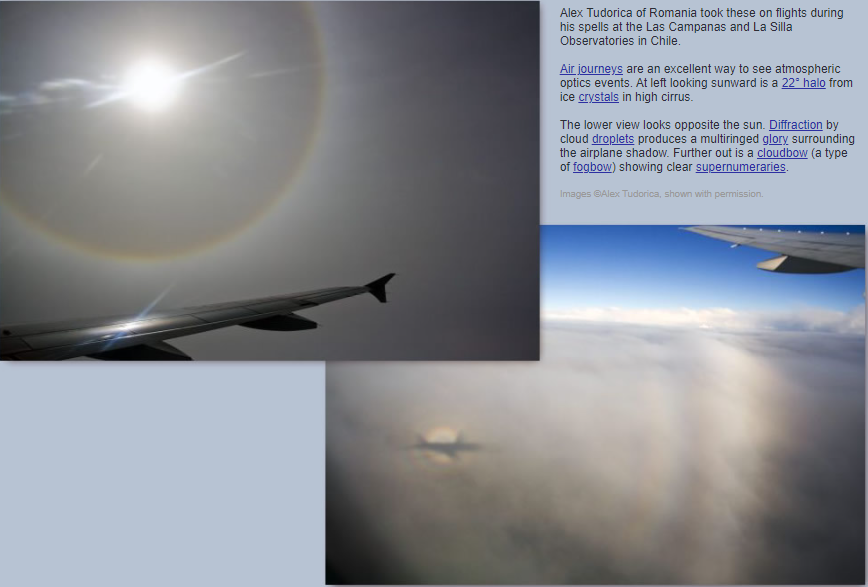Airplane Optics
Airplane Optics: A Window into Atmospheric Phenomena
Airplane journeys offer a unique perspective for observing atmospheric optics events. As passengers look out the window during their flight, they may be treated to captivating displays of light and color caused by the interaction of sunlight with atmospheric particles. In this article, we will explore some of the fascinating phenomena that can be observed from the vantage point of an airplane.
One common atmospheric optics event that can be seen from an airplane is a 22° halo. This halo appears as a circular ring around the sun and is caused by the refraction and reflection of sunlight by ice crystals in high cirrus clouds. The ice crystals act as tiny prisms, bending the sunlight and creating the halo effect. It is a mesmerizing sight, showcasing the beauty and complexity of our atmosphere.
Another phenomenon that can be observed from an airplane is known as a glory. This optical phenomenon occurs when sunlight is scattered backwards by water droplets in clouds. The result is a multiringed halo surrounding the shadow of the airplane on the cloud layer below. The rings of the glory are formed due to diffraction, which causes interference patterns in the scattered light. Additionally, if the cloud droplets are of a specific size, a cloudbow, similar to a fogbow, may also be visible, displaying clear supernumerary arcs within its structure.
As passengers gaze out the window opposite the sun, they may also witness the spectacle of crepuscular rays. These rays, often referred to as "sunbeams," are shafts of sunlight that appear to radiate from the position of the sun. They are caused by the scattering and absorption of sunlight by particles in the atmosphere, such as dust or water droplets. When these particles are present in the air, they scatter sunlight in all directions, creating a dramatic visual effect.
In addition to these well-known phenomena, airplane passengers may also have the opportunity to observe other rare atmospheric optics events. For example, they may witness the elusive green flash, a brief green light that can sometimes be seen on the horizon just after sunset or just before sunrise. This phenomenon occurs due to the refraction of sunlight as it passes through the Earth's atmosphere, causing different colors of light to be refracted at slightly different angles.
Furthermore, passengers may be fortunate enough to spot a circumhorizontal arc, also known as a fire rainbow. This optical phenomenon appears as a vibrant, horizontal band of colors in the sky. It is caused by the refraction of sunlight through hexagonal ice crystals in cirrus clouds. The crystals act as prisms, separating the sunlight into its component colors and creating a stunning display of hues.
While airplane optics provide an extraordinary opportunity to witness these atmospheric phenomena, it is important to note that their visibility is dependent on various factors. The presence and type of clouds, the position of the sun relative to the observer, and the atmospheric conditions all play a role in determining whether these optical events will be visible during a flight.
In conclusion, airplane optics offer a captivating glimpse into the wonders of atmospheric phenomena. From the ethereal 22° halo and multiringed glory to the mesmerizing crepuscular rays and rare green flashes, passengers have the chance to witness these awe-inspiring displays from the comfort of their airplane seat. So, next time you find yourself flying high above the clouds, don't forget to look out the window and marvel at the beauty that lies in the skies above.

Alex Tudorica of Romania took these on flights during his spells at the Las Campanas and La Silla Observatories in Chile.
Air journeys are an excellent way to see atmospheric optics events. At left looking sunward is a 22° halo from ice crystals in high cirrus.
The lower view looks opposite the sun. Diffraction by cloud droplets produces a multiringed glory surrounding the airplane shadow. Further out is a cloudbow (a type of fogbow) showing clear supernumeraries.
Images ©Alex Tudorica, shown with permission.
Note: this article has been automatically converted from the old site and may not appear as intended. You can find the original article here.
Reference Atmospheric Optics
If you use any of the definitions, information, or data presented on Atmospheric Optics, please copy the link or reference below to properly credit us as the reference source. Thank you!
-
<a href="https://atoptics.co.uk/blog/airplane-optics/">Airplane Optics</a>
-
"Airplane Optics". Atmospheric Optics. Accessed on April 16, 2024. https://atoptics.co.uk/blog/airplane-optics/.
-
"Airplane Optics". Atmospheric Optics, https://atoptics.co.uk/blog/airplane-optics/. Accessed 16 April, 2024
-
Airplane Optics. Atmospheric Optics. Retrieved from https://atoptics.co.uk/blog/airplane-optics/.